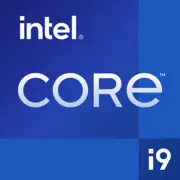Intel Core i9-12900HX

Intel Core i9-12900HX: The Power of Alder Lake in Laptops – A Comprehensive Review
March 2025
Introduction: Why the Core i9-12900HX in 2025?
Even three years after its release, the Intel Core i9-12900HX remains relevant for demanding users. It is one of the first mobile chips with the hybrid Alder Lake architecture, combining high performance and flexibility. In 2025, laptops featuring this CPU can be found at reduced prices (starting from $1500) in the gaming and workstation segments. Let's explore who it suits and what it's capable of.
1. Architecture and Process Technology: The Hybrid Revolution
Cores, Threads, and Cache
The Core i9-12900HX is built on the hybrid Alder Lake architecture:
- 16 cores (8 Performance-Cores + 8 Efficient-Cores).
- 24 threads (P-cores support Hyper-Threading, E-cores do not).
- P-cores: Maximum turbo frequency — 5.00 GHz, base — 2.5 GHz.
- E-cores: Turbo up to 3.6 GHz, base frequency — 1.8 GHz.
- L3 Cache — 30 MB, L2 — 14 MB.
The Intel 7 process (equivalent to 10nm Enhanced SuperFin) provides a balance between energy efficiency and performance.
Integrated Graphics
The integrated GPU is Intel UHD Graphics for 12th generation (96 EUs, up to 1.45 GHz). It is suitable for office tasks, viewing 4K videos, and light gaming (for instance, Dota 2 at medium settings yields 40-50 FPS). Serious gaming or rendering will require a discrete graphics card (RTX 3070 or higher).
2. Power Consumption and TDP: The Cost of Power
The nominal TDP of the processor is 55 watts, but in turbo mode, power consumption can reach 157 watts. This creates two challenges:
1. Thermal Output: Without an efficient cooling system (like a pair of fans and heat pipes), the chip quickly overheats, causing throttling.
2. Battery Life: In laptops with this CPU, battery life rarely exceeds 4-5 hours under active use.
Example: In the slim ultrabook ASUS ZenBook Pro 16 (2023) with the i9-12900HX and a 96 Wh battery, web surfing time is 6 hours, but when rendering video in DaVinci Resolve, the laptop drains within 1.5 hours.
3. Performance: Real-World Task Tests
Office and Multimedia
- Geekbench 6: 2448 (Single-Core) / 13518 (Multi-Core). For comparison, the Apple M2 Pro (2023) scores 2650/14500 but only in macOS applications.
- Chrome with 50+ tabs + Photoshop: No delays even when running tasks in parallel.
Gaming
With a discrete GPU (e.g., RTX 4080):
- Cyberpunk 2077 (1440p, Ultra): 75-90 FPS with DLSS 3.
- Microsoft Flight Simulator (4K): 45-60 FPS.
Turbo Mode: P-core frequencies remain at 4.8-5.0 GHz for the first 2-3 minutes, then drop to 4.3-4.5 GHz due to heating.
4. Use Scenarios: Who is the i9-12900HX Suitable For?
- Professionals: Video editors, 3D designers, engineers (AutoCAD, Blender, Premiere Pro).
- Gamers: For 2K/4K gaming with high settings.
- Enthusiasts: Those who value upgradeability (laptops with this CPU often have slots for SSDs and RAM).
Who Should Avoid It:
- Users prioritizing battery life (better to consider Apple M3 or AMD Ryzen 7 8840U).
- Budget shoppers: Laptops with the i9-12900HX start at $1500 (in 2025).
5. Battery Life: How Long Does the Laptop Last?
- Power Saving: Intel Speed Shift, Dynamic Tuning 2.0. In "Power Saving" mode, E-cores handle background tasks while P-cores are disabled.
- Real Figures:
- YouTube Streaming (50% brightness): 4-5 hours.
- Text editing + music: 6-7 hours.
- Gaming or rendering: 1-1.5 hours.
Tip: Choose laptops with a battery of at least 90 Wh and fast charging support (e.g., MSI Raider GE78HX).
6. Comparison with Competitors
AMD Ryzen 9 7945HX (2023):
- Pros: Better energy efficiency, 16 fully-fledged Zen 4 cores.
- Cons: Weaker in single-threaded tasks (Geekbench 6 Single-Core — 2200).
Apple M3 Max (2024):
- Pros: Battery life of up to 12 hours, macOS ecosystem.
- Cons: Limited compatibility with Windows software.
Intel Core i9-13900HX:
- Pros: +10% performance, improved Intel 4 process.
- Cons: Costs $200-300 more.
7. Pros and Cons of the Core i9-12900HX
Strengths:
- Record multi-threaded performance.
- Support for DDR5-4800 and PCIe 5.0.
- Optimization for Windows 11 (Thread Director scheduler).
Weaknesses:
- High heat output under load.
- Short battery life.
- Requires expensive cooling solutions.
8. Recommendations for Choosing a Laptop
- Gaming Models: MSI Titan GT77, ASUS ROG Strix Scar 17 — focus on cooling and discrete graphics.
- Workstations: Dell Precision 7770, Lenovo ThinkPad P16 — certified for professional applications.
What to Focus On:
- Cooling system: At least 2 fans, 5 heat pipes.
- Display: For professionals — 4K with 100% DCI-P3; for gamers — 240 Hz QHD.
- Ports: Thunderbolt 4, HDMI 2.1, SD card reader.
9. Final Conclusion: Is It Worth Buying in 2025?
The Core i9-12900HX is the choice for those needing maximum power in a mobile format. Key Benefits:
- Versatility: Gaming, video editing, 3D modeling.
- Compatibility: Works with any Windows software and hardware.
- Price: Reduction of 30-40% compared to 2023.
Ideal User: A gamer, designer, or engineer who can tolerate the laptop's weight (starting from 2.5 kg) and the necessity to keep a charger handy. If battery life and quiet operation are priorities, consider the Apple M3 or AMD Ryzen 9 8945HS.
Main Advice for 2025: When purchasing a laptop with the i9-12900HX, check for BIOS and driver updates — Intel continues to optimize the performance of hybrid cores even for "older" chips.
Basic
CPU Specifications
Memory Specifications
GPU Specifications
Miscellaneous
Benchmarks
Compared to Other CPU
Share in social media
Or Link To Us
<a href="https://cputronic.com/cpu/intel-core-i9-12900hx" target="_blank">Intel Core i9-12900HX</a>